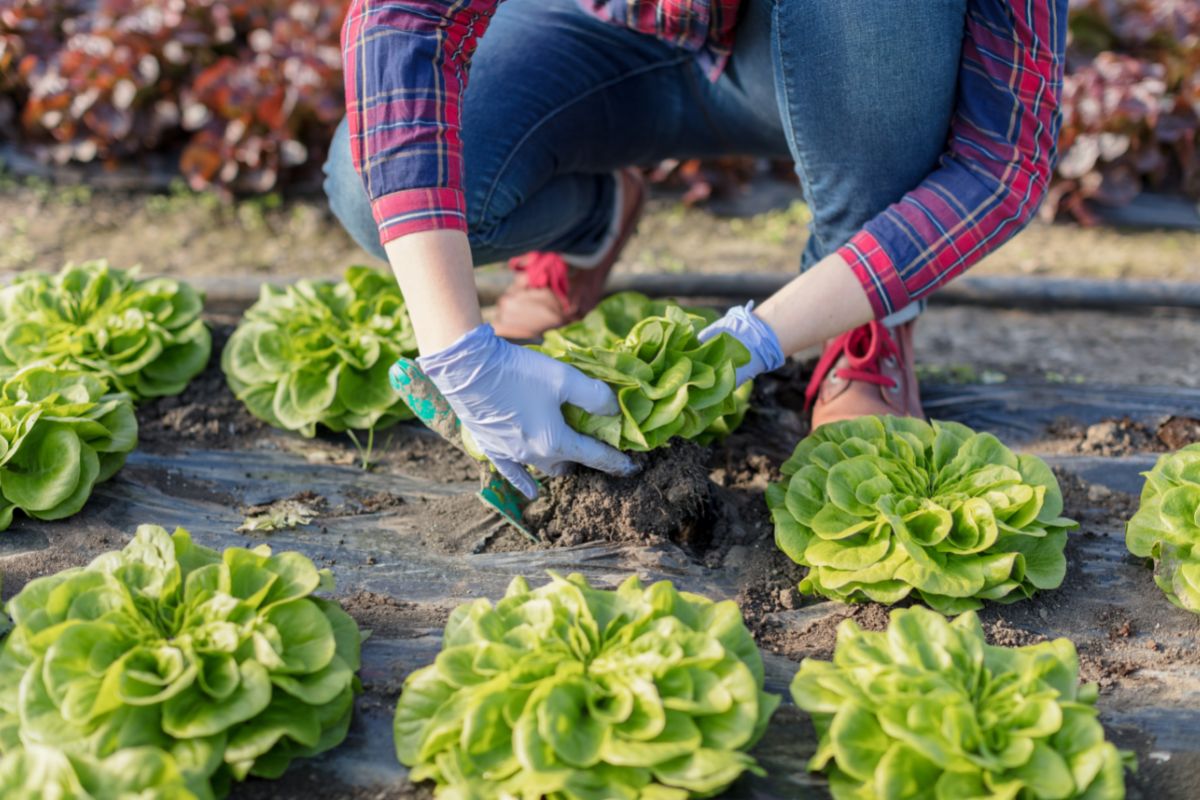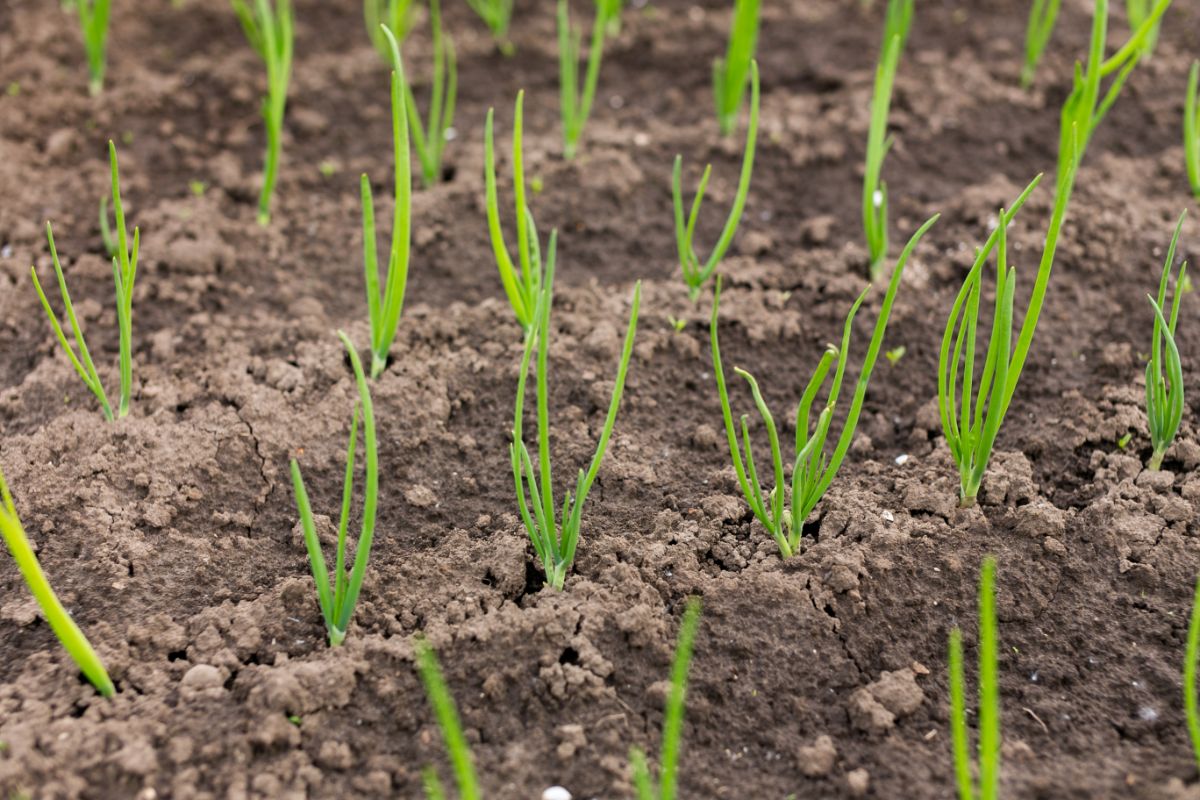Lettuce is a very easy vegetable to grow in your garden. It grows quickly and can be harvested at any time of the year, even during winter months.

Most lettuce varieties are ready for harvest once they reach their full size. This means that you should begin harvesting as soon as possible after planting.
You will want to pick them when they have reached about 2 inches tall. The best way to tell if it’s time to harvest is by looking at the leaves.
If they look healthy and green, then they are ready to go.
Harvesting Lettuce
There are many ways to harvest lettuce. Some people like to pull up the entire plant, while others prefer to cut off individual heads.
Either method works well. When harvesting lettuce, make sure that you remove all the dirt from around the roots.
This will help prevent disease or rot from spreading. Once you have removed all the soil, wash the plants with water.
Then use a sharp knife to cut off the head. Make sure that you do not cut into the stem.
After cutting off the head, place it on a clean towel so that it dries out.
What To Avoid When Harvesting Lettuce
When harvesting lettuce, avoid touching the leaves with your hands. Many diseases and pests can be spread through this contact.
Also, try not to touch the head directly. Instead, use gloves or tongs. These tools will keep you safe from getting sick or having problems later on.
Another thing to remember is that you need to wear rubber boots when working in your garden.
Rubber boots protect against diseases and insects. They also protect the ground below the plants from being damaged.
Finally, always wear long sleeves and pants when working in the garden. Wearing these items will protect you from coming into contact with harmful bacteria.
Growing Lettuce
If you are interested in growing lettuce, there are several things that you need to consider before doing so.
First, you need to choose the right variety of lettuce. There are many types of lettuce available. Some are more cold-tolerant than others.
Others are more heat tolerant. Choose one that matches your growing conditions. Next, you need to decide where you would like to grow your lettuce.
If you live in an area with wild winters, you may want to grow it indoors. Indoor gardens allow you to control the temperature and humidity levels.
Whether you are growing your lettuce indoors or outdoors, you will need to prepare the bed first.
This includes adding compost and fertilizer. You will also need to provide adequate sunlight.
Growing Lettuce In Your Garden
You may think that growing lettuce in your backyard would be difficult. However, it’s actually quite simple.
All you need to do is prepare the area where you plan to grow lettuce. First, dig a hole large enough for the root ball.
Next, add some compost to the bottom of the hole. Then, fill the hole with potting soil.
After filling the hole, gently press down the soil until it reaches the top of the container.
At this point, you can start adding fertilizer. Add one tablespoon of fish emulsion per gallon of water.
Use this mixture every two weeks. You can also fertilize the plants using liquid fertilizer.
A good amount of nitrogen is needed to grow lettuce successfully. Liquid fertilizer contains 20-30 percent nitrogen.
You can apply this liquid fertilizer to the base of each plant. You can also spray the leaves with a solution containing 10-15 percent nitrogen.
Lettuce needs a lot of sunlight to grow properly. If the weather conditions are too cold, you may need to cover the plants with plastic wrap.
This allows the sun to warm the plants.
Lettuce is an excellent choice for those who love fresh salad greens. There are many types of lettuce available.
Some of the most popular include romaine, butterhead, leaf, green oak leaf, red oak leaf, and bibb.
Each type has its own unique characteristics. For instance, bibb lettuce tends to be more tender than other varieties.
Romaine lettuce is often used as a substitute for iceberg lettuce. It grows quickly and tastes great.
Butterhead lettuce is very versatile. It can be eaten raw or cooked. Green oak leaf lettuce is best served uncooked.
Red oak leaf lettuce is similar to romaine, but has a milder flavor.
How To Grow And Harvest Lettuce Indoors
If you want to grow lettuce indoors, you should first figure out what variety you would like to grow.
Next, select a location in the house that receives indirect light. A south facing window works well for this purpose.
After planting the seeds, wait about three days before watering them. Then, continue to water the seedlings regularly.
Once they reach four inches tall, transplant them into individual pots. Be sure to give the plants plenty of space.
When the plants begin to flower, cut off the stalks. The flowers will die if left alone. At this time, remove any dead leaves.
Water the plants daily and keep the temperature at around 70 degrees Fahrenheit. As soon as the plants have set fruit, harvest them by cutting the stem just above the head.
Let the heads dry on the countertop for several days before storing the harvested lettuce in the refrigerator.
How To Grow Lettuce From Seed
Growing lettuce from seed is easy. First, purchase a packet of mixed lettuce seeds. Plant these seeds directly in the garden once all danger of frost has passed.
When the plants begin to sprout, thin them so that only one plant remains. Continue to keep the soil moist until the plants are ready to harvest.
Then, harvest them accordingly whilst being careful not to damage the leaves.
Growing Lettuce In Containers
To grow lettuce in containers, use a potting mix that drains well. Add some compost to the mix to increase the nutrients available to your plants.
Fill the container with the potting mix. Make sure that there is enough room for the roots to spread out and place the container in a sunny area.
Water the plants regularly and fertilize them accordingly.
How To Grow Lettuce In Pots
You can also grow lettuce in pots. You should use a good quality potting mix. You can also add some fertilizer to the mix.
Fill the pot with the potting mix and place it in a sunny spot. Then, water the plants regularly and fertilize them when needed.
Growing Lettuces In The Garden
Lettuce is a hardy vegetable that can be grown successfully outdoors year round.
If you live in a cold climate, you may need to protect the plants during winter months. This can be done by covering the bed with straw, hay, or mulch.
Alternatively, you can cover the plants with plastic wrap.
Why Is Lettuce So Good For You?
Health Benefits Of Lettuce
1) Lettuce Contains Vitamin C
Vitamin C helps maintain healthy skin and aids in wound healing.
2) Lettuce Contains Folate, Which Helps Prevent Birth Defects
Folate also helps reduce homocysteine levels in the blood, which may help lower the risk of heart disease.
3) Lettuce Is High In Fiber
Fiber helps promote regularity and prevents constipation.
4) Lettuce Is Low In Calories
One cup of chopped lettuce contains only 20 calories.
5) Lettuce Is Rich In Antioxidants
Antioxidants fight free radicals in the body. Free radicals cause cell damage and aging.
6) Lettuce Is An Excellent Source Of Iron
Iron is essential for red blood cells. Red blood cells carry oxygen throughout the body.
7) Lettuce Is A Great Source Of Potassium
Potassium promotes growth and strengthens bones and muscles. It also helps regulate heartbeat and nerve function.
8) Lettuce Is Very Low In Sodium
Sodium causes water retention and swelling.
9) Lettuce Is Packed With Vitamins A And B
These vitamins support bone health, immune system, and cardiovascular health.
10) Lettuce Is Loaded With Calcium
Calcium supports strong teeth and bones. It also helps control muscle contractions.
11) Lettuce Is Full Of Folic Acid
Folic acid helps prevent birth defects.
12) Lettuce Is Chock-Full Of Vitamin D
Vitamin D is necessary for proper absorption of calcium.
13) Lettuce Is Extremely High In Vitamin E
Vitamin E is important for maintaining healthy skin and preventing premature aging.
14) Lettuce Is Bursting With Vitamin K
Vitamin K is necessary for the formation of blood clots.
Conclusion
To conclude, you can harvest lettuce from your garden at any time of the year.
However, if you want to enjoy fresh lettuce all summer long, plant lettuce seeds indoors about six weeks before the last frost date.
When you transplant the seedlings into the garden, make sure they are well watered and fertilized throughout the growing process and be careful not to damage the leaves when harvesting.
- Pull Sprouts: 1 Potato Peel, 200 Plants - July 7, 2022
- Creeping Thyme: Flowering Herb And Ground Cover - July 7, 2022
- East meets Midwest in the garden of Linda Brazill and Mark Golbach, Part 1 - July 7, 2022






